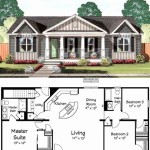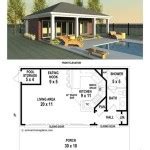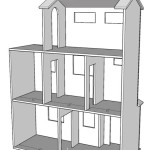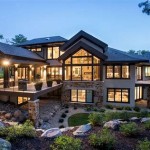A house plan with an RV garage is a type of residential design that incorporates a dedicated space for the storage and protection of recreational vehicles (RVs), such as motorhomes, travel trailers, or campervans. These garages are typically larger than standard garages, allowing ample room for maneuvering and accommodating the unique dimensions of RVs.
Incorporating an RV garage into a home plan provides numerous benefits. RV enthusiasts enjoy the convenience of having their vehicles securely stored at their residence, eliminating the need for off-site storage facilities. The protected environment of the garage helps safeguard RVs from the elements, preventing damage from extreme temperatures, rain, snow, and sunlight. Additionally, having an RV garage onsite simplifies maintenance and cleaning, as owners can easily access their vehicles for repairs or routine upkeep.
Moving forward, we will delve into the key considerations when designing house plans with RV garages, including space requirements, structural design, and integration with the home’s overall layout.
When designing house plans with RV garages, it’s essential to consider the following key points:
- Adequate Space
- Structural Support
- Garage Door Size
- Electrical and Plumbing
- Ventilation
- Access and Maneuvering
- Exterior Design
- Local Regulations
By carefully addressing these aspects, homeowners can create functional and aesthetically pleasing house plans that seamlessly integrate RV storage into their living spaces.
Adequate Space
When designing a house plan with an RV garage, determining the appropriate amount of space is crucial. The garage should be large enough to accommodate the RV comfortably, allowing for easy entry, exit, and maneuvering. Consider the following factors:
- RV Dimensions: Measure the length, width, and height of your RV to ensure it will fit within the garage. Allow for additional clearance on all sides to prevent any damage when parking or retrieving the vehicle.
- Maneuvering Space: Plan for ample space around the RV to allow for safe and convenient maneuvering. This includes space for turning, backing up, and accessing the RV’s doors and compartments.
- Storage and Utilities: If you plan to store additional items or equipment in the garage, such as tools, bikes, or outdoor gear, allocate sufficient space for these items. Consider installing shelves, cabinets, or a workbench for storage and organization.
- Future Expansion: If you anticipate upgrading to a larger RV in the future, design the garage with additional space to accommodate the potential increase in size.
By carefully considering these factors and providing adequate space, you can create an RV garage that meets your current and future needs, ensuring a functional and enjoyable space for your recreational vehicle.
Structural Support
Ensuring adequate structural support is critical when designing house plans with RV garages. The garage must be able to withstand the weight of the RV, as well as any additional storage or equipment. The following factors should be considered:
- Foundation: The foundation of the garage should be designed to support the weight of the RV. This may require reinforced concrete or other sturdy materials.
- Walls: The walls of the garage should be constructed using materials that can withstand the force exerted by the RV. Concrete, steel, or reinforced wood are common choices.
- Roof: The roof of the garage should be strong enough to support the weight of the RV, as well as any snow or wind loads that may occur in your area. Trusses or beams made of steel or engineered wood are often used.
- Door: The garage door should be large enough to accommodate the RV and should be designed to withstand the weight and force of the vehicle. Roll-up doors or sectional doors made of steel or aluminum are common choices.
By carefully considering these factors and incorporating appropriate structural support measures, you can ensure the safety and stability of your RV garage.
Garage Door Size
The size of the garage door is a crucial consideration in house plans with RV garages. The door must be large enough to accommodate the RV’s height, width, and length, while also allowing for sufficient clearance on all sides. Here are some key factors to consider:
- RV Dimensions: Measure the height, width, and length of your RV to determine the minimum required dimensions for the garage door. Add at least 12 inches of clearance on all sides to allow for safe entry and exit.
- Door Type: Roll-up doors and sectional doors are common choices for RV garages. Roll-up doors are made of a single sheet of material that rolls up vertically, while sectional doors are made of multiple panels that hinge together. Consider the height and clearance requirements of your RV when choosing the door type.
- Headroom: Ensure that the garage door has sufficient headroom to accommodate the RV’s height, including any roof-mounted accessories such as air conditioners or satellite dishes.
- Side Clearance: Provide ample side clearance on both sides of the garage door to allow for the RV’s mirrors and any slide-outs.
- Insulation and Weatherstripping: Choose a garage door with good insulation and weatherstripping to maintain a comfortable temperature inside the garage and prevent drafts.
By carefully considering these factors and selecting an appropriately sized garage door, you can ensure that your RV garage provides easy access and protection for your recreational vehicle.
Electrical and Plumbing
When designing house plans with RV garages, careful consideration should be given to the electrical and plumbing systems to ensure they meet the unique needs of an RV. Here are some key points to consider:
- Electrical Outlets: Provide ample electrical outlets throughout the garage, including both 110-volt and 220-volt outlets. These outlets will be used to power the RV’s electrical systems, as well as any additional appliances or tools stored in the garage.
- Lighting: Install adequate lighting in the garage to ensure good visibility when working on or accessing the RV. Consider a combination of overhead lighting and task lighting for specific areas.
- RV Electrical Hookup: Install a dedicated electrical hookup outside the garage to connect the RV’s electrical system to the home’s electrical panel. This will allow for convenient charging of the RV’s batteries and powering of its appliances.
- Water Supply: Provide a water supply in the garage for easy access to water for cleaning or maintenance tasks. Consider installing a hose bib or a sink with running water.
By carefully planning the electrical and plumbing systems in your RV garage, you can ensure that it is a functional and convenient space for storing and maintaining your recreational vehicle.
Ventilation
Proper ventilation is essential in house plans with RV garages to maintain a healthy and comfortable environment. Adequate airflow helps prevent the buildup of moisture, fumes, and odors, which can damage the RV and pose health risks.
- Exhaust Fans: Install exhaust fans in the garage to remove moisture and fumes generated by the RV’s engine, appliances, and any other sources. These fans should be vented directly to the outside of the garage.
- Passive Ventilation: Incorporate passive ventilation measures such as vents or louvers in the walls or roof of the garage to allow for natural airflow. This helps circulate fresh air and reduce the accumulation of stale air.
- Insulation and Air Sealing: Ensure that the garage is well-insulated and air-sealed to prevent moisture and cold air from entering. This will help maintain a consistent temperature and reduce the risk of condensation.
- Carbon Monoxide Detectors: Install carbon monoxide detectors in the garage to alert you to the presence of this deadly gas, which can be produced by the RV’s engine or other combustion appliances.
By incorporating these ventilation measures into your RV garage design, you can ensure a well-ventilated and healthy environment for your RV and yourself.
Access and Maneuvering
Ensuring easy access and ample maneuvering space is crucial in house plans with RV garages. Careful planning allows for safe and convenient entry, exit, and movement of the RV within the garage.
Driveway Design: Design the driveway leading to the garage to provide a gradual slope and sufficient width to accommodate the RV’s turning radius. Avoid sharp angles or obstacles that could hinder maneuvering.
Garage Door Placement: Position the garage door at a suitable location on the property to allow for a clear and unobstructed path for the RV. Consider the proximity to the street, other structures, and any potential obstacles.
Garage Size: Provide ample space within the garage to allow for comfortable maneuvering of the RV. Consider the length, width, and height of the RV, as well as any slide-outs or awnings that may extend.
Turning Radius: Ensure that the garage provides a turning radius that allows the RV to enter, exit, and park without difficulty. This may require widening the garage or incorporating a circular driveway.
Exterior Design
The exterior design of house plans with RV garages plays a crucial role in enhancing the overall aesthetics and functionality of the property. Here are some key considerations to ensure a cohesive and visually appealing design:
- Architectural Style: Choose an architectural style for the garage that complements the main house and the surrounding environment. Consider the materials, colors, and overall design elements to create a harmonious and visually pleasing exterior.
- Materials and Finishes: Select durable and aesthetically pleasing materials for the garage’s exterior, such as siding, roofing, and trim. Consider materials that are resistant to weather conditions and require minimal maintenance.
- Roof Design: The roof of the garage should complement the architectural style of the house and provide adequate coverage and protection for the RV. Consider the slope, pitch, and materials used to ensure a well-designed and functional roof.
- Landscaping: Integrate the garage seamlessly into the surrounding landscape by incorporating landscaping elements such as trees, shrubs, and flower beds. This helps create a cohesive outdoor space and enhances the overall curb appeal of the property.
By carefully considering these exterior design elements, you can create a house plan with an RV garage that not only provides functionality but also enhances the aesthetic appeal of your home.
Local Regulations
When designing house plans with RV garages, complying with local regulations is crucial to ensure the safety, functionality, and aesthetic appeal of your property. These regulations may vary depending on your specific location and jurisdiction.
- Setbacks and Property Lines: Local regulations often dictate the minimum distance that a structure, including an RV garage, must be set back from property lines and neighboring structures. These setbacks ensure adequate space for access, maintenance, and fire safety.
- Height Restrictions: Some localities impose height restrictions on garages and other outbuildings. These restrictions aim to maintain neighborhood aesthetics and prevent structures from obstructing views or interfering with aircraft flight paths.
- Garage Size and Placement: Local regulations may limit the maximum size and placement of detached garages. These regulations consider factors such as lot size, zoning restrictions, and the overall character of the neighborhood.
- Permits and Inspections: Most localities require building permits before constructing an RV garage. The permitting process ensures that the plans meet local building codes and safety standards. Inspections are also typically conducted during and after construction to verify compliance.
It’s essential to research and understand the local regulations applicable to your area before finalizing your house plans with an RV garage. Adhering to these regulations ensures a smooth construction process and avoids potential legal issues or conflicts with neighbors.










Related Posts








